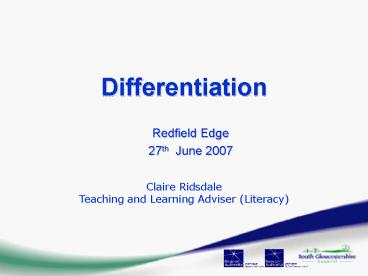Differentiation - PowerPoint PPT Presentation
1 / 22
Title: Differentiation
1
Differentiation
- Redfield Edge
- 27th June 2007
Claire Ridsdale Teaching and Learning Adviser
(Literacy)
2
Aims
- To discuss the rationale for differentiation
- To consider differentiation strategies
- To look at differentiation in practice
- To consider next actions as a school
3
Differentiation the Circles of Inclusion
4
What Evidence Do We Have?
- Recent summative assessments
- Frequent, accurate and insightful formative
assessment - Different forms of evidence for the same
learning eg. - pupils with difficulties in writing may record
their work)
5
Some, Most and All
- All pupils
- Must gain the basic learning
- Most pupils
- Should achieve in line with national
expectations - Some pupils
- Could work towards a higher level
6
Making Decisions
Review objectives for the unit Identify which
objectives can be accessed by the whole
class Identify which objectives could be
accessed with support and how this may be
provided Identify which objectives could, if
necessary, be interpreted or simplified to allow
certain groups to focus on the core
learning Identify which objectives cannot be
accessed by or simplified for one or more
groups Plan a learning activity to address the
missing skills which make the general lesson
objectives unsuitable for some pupils
7
Types of Differentiation
8
Types of Differentiation
9
Types of Differentiation
Task
Outcome
What sort of things would you expect to see for
each of these?
Support
Response
10
Differentiation by Outcome
- Pupils given precisely the same task.
- Discriminates by length, quality, complexity,
standard of - work, pace, sophistication, conclusions reached
etc. - Is appropriate at times when used with
differentiation - in marking.
- Measures pupil output rather than promoting
- differing standards.
- Limited strategy, should not routinely be used
- as the main form of differentiation.
11
Differentiation by Task
Differentiation by task varies the level of
challenge posed to pupils of different abilities
by
NC level Imposing constraints Complexity (No. of
steps) Amount of work Time Accuracy Use of
Blooms Difficulty (knowledge required) Amount of
steer towards answer
12
Differentiation by Support
- Varies the ways in which pupils are helped in
accessing, - interpreting or completing their tasks.
- Achieved in three main ways
- Offering different levels of support provided by
adults - Varying the materials or resources made
available to - support the pupil
- Varying the extent to which pupils work
collaboratively or - independently
13
Differentiation by Response
- Varies the balance of support and challenge
provided - by the teacher
- Teacher modifies written and/or spoken responses
to - both in discussion with pupils and in marking
their work
14
Blooms Taxonomy
Six levels of thinking in ascending order of
cognitive ability Knowledge Comprehension App
lication Analysis Evaluation Synthesis
15
Initial Levels of Thinking
- Comprehension
- Can explain or translate what
- has been learnt
- Can summarise main points,
- solve word problems, predict.
- Knowledge
- Can identify, list, describe
- memorise information
- Can ask/answer Who?
- What? Where?
- Application
- Can transfer knowledge from one situation to
another - Can apply information in different contexts
- Can make links
16
Higher Levels of Thinking
- Analytical
- Can build on existing knowledge
- Can infer and deduce
- Can categorise information
- find patterns to form
- generalisations
- Evaluation
- Can appraise ideas
- Can describe justify
- reasons
- Can assess, compare and
- contrast
- Synthesis
- Can look at things in new ways
- Can form hypotheses original ideas
- Can design, create and compose
17
Task
Sort the questions into Application, Analysis,
Evaluation and Synthesis Add one of your own for
each category
18
Knows the difference between fiction and
non-fiction Understands the features of different
non-fiction text types (eg. reports,
discussions) Can use the features of report
writing in their own report Can analyse own
writing against key features checklist Can
identify areas where improvements can be made Can
use previous learning in their next report
19
Planning
- Needs to be differentiated appropriately for
different - groups of learners
- May involve differentiation by outcome for
speaking and - listening activities
- Reading/writing activities should be
differentiated by task - Showing all literacy groups on your planning
sheet - makes it easier to track a groups learning
through the - week
20
From worksheets to
Labelling
Film/video clips
Sequencing
Paired work/ whiteboards
Recording/ photographing/ animating
Drawing annotating
Highlighting
Making
Speaking listening strategies
21
Example
22
Planning
- Read through Y4 Issues and Dilemmas unit
- In pairs, plan differentiated activities for Tues
and Wed of - the second week
23
Plenary
- What will be your next steps as a school?































